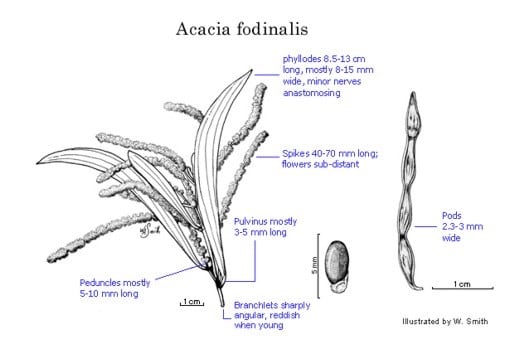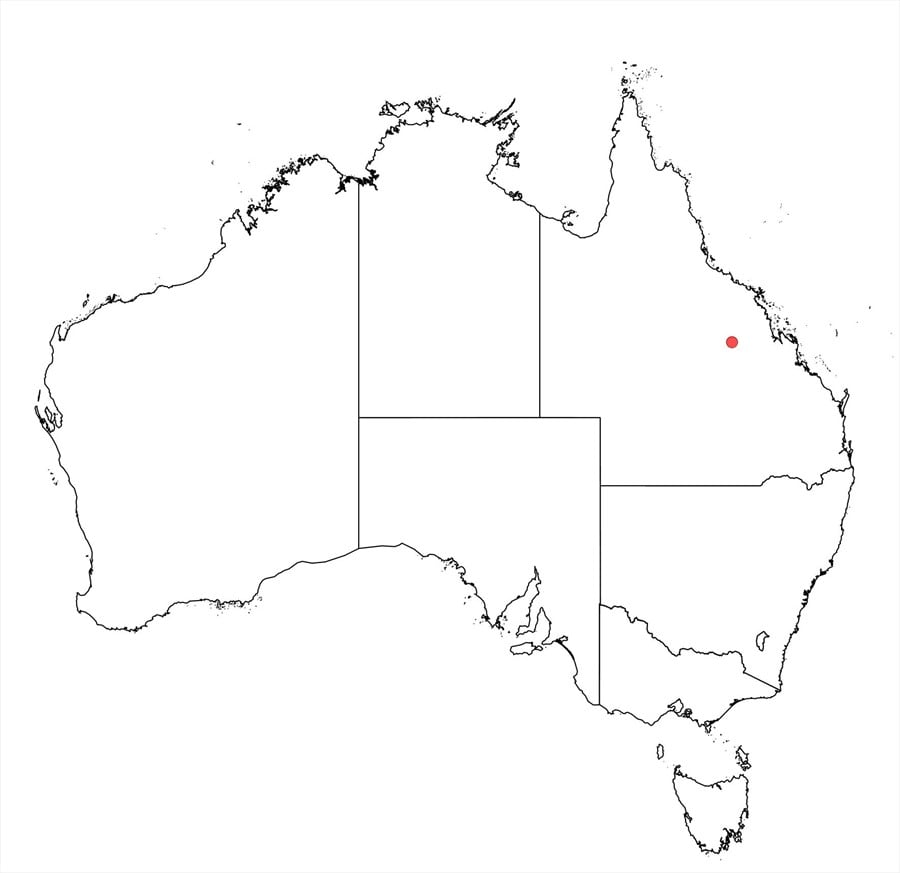Acacia fodinalis Pedley
WATTLE
Acacias of Australia
Family
Fabaceae
Distribution
Occurs in the upper part of the Isaacs R. basin and adjacent part of the Belyando R. basin, Qld.
Description
Trees 4–10 m high. Branchlets acutely angled and somewhat slender at extremities, soon terete, glabrous, reddish, resinous when young. Phyllodes mostly shallowly falcate, tapering equally at both ends, acute, 8.5–13 cm long, 8–15 (–20) mm wide, glabrous; longitudinal nerves parallel and crowded (3–4 per mm), 2 or 3 main nerves more pronounced than the rest and running together near base and sometimes contiguous with lower margin, anastomoses few but consistently present; pulvinus (2–) 3–5 mm long, yellow or more commonly brownish when dry; gland 0–1 mm above pulvinus, prominent, a distinct swelling of margin with a marked orifice. Inflorescences simple; peduncles 5–10 (–15) mm long, glabrous. Spikes 4–7 cm long, golden, the flowers distant or subdistant. Flowers 5-merous; calyx gamosepalous, cupular, glabrous or with a few hairs near the base. Pods (few seen and rather depauperate) linear, prominently raised over seeds and slightly constricted between them, longitudinally wrinkled on the convexity, to c. 4.5 cm long, 2.3–3 mm wide, straight, dark brown, pruinose, glabrous, marginal nerve yellow. Seeds longitudinal, light brown, c. 3.5 mm long; pleurogram rectangular; aril yellow.
Habitat
Normally grows on sandy soils often associated with Eucalytpus crebra.
Specimens
Qld: 2 mi. [c 3 km] N of ‘Logan Downs’ Stn, L.Adams 1263 (BRI, ex CANB); 17 mi. [27 km] E of ‘Pasha’ homestead, L.Pedley 1727A (BRI); Peak Downs Hwy at top of Eton Ra., Champion 1341 & Ritchie (BRI).
Notes
A member of the taxonomically complex ‘A cunninghamii group’ (see A. concurrens) closely related to A. leiocalyx but according to L.Pedley, Austrobaileya 5: 316, 318 (1999), A. fodinalis develops into a large plant and normally has narrower, more elongate phyllodes (more than 7.5 times longer than wide), with often more crowded secondary longitudinal nerves, longer pulvinuses, spikes on longer peduncles, at least a few hairs at the base of the calyx and narrower pods. However, it is often difficult to separate the two species, especially from herbarium material. Intergrades with A. cretata in the Emerald–Blackwater–Duaringa area, fide L.Pedley, Austrobaileya 5(2): 318 (1999).
FOA Reference
Data derived from Flora of Australia Volumes 11A (2001), 11B (2001) and 12 (1998), products of ABRS, ©Commonwealth of Australia
Author
B.R.Maslin
This identification key and fact sheets are available as a mobile application:
URL: https://apps.lucidcentral.org/wattle/
© Copyright 2018. All rights reserved.







